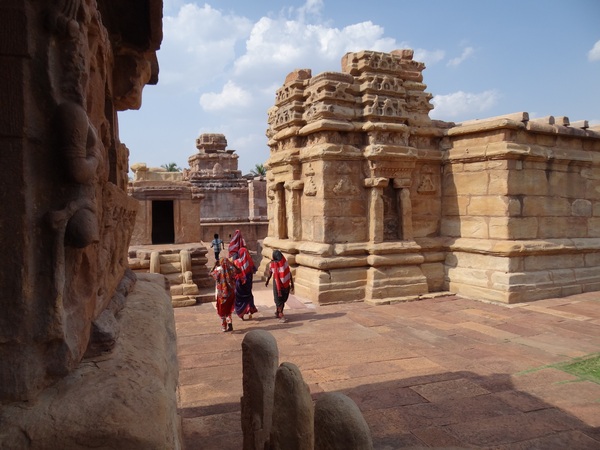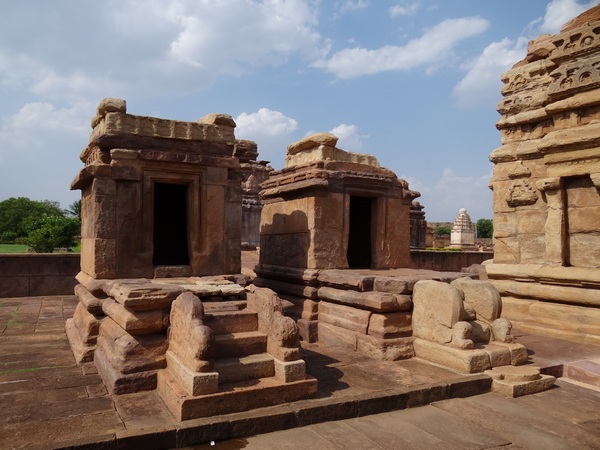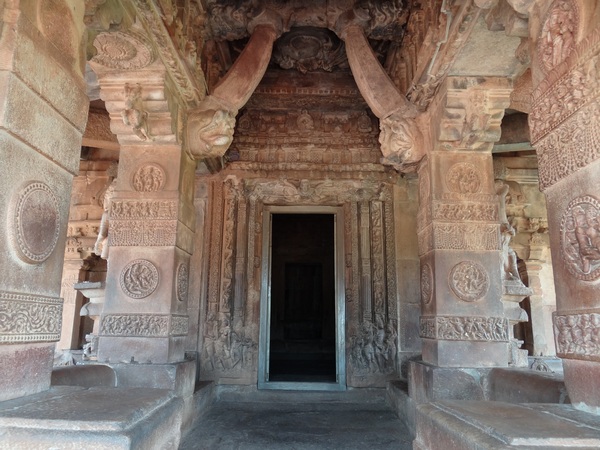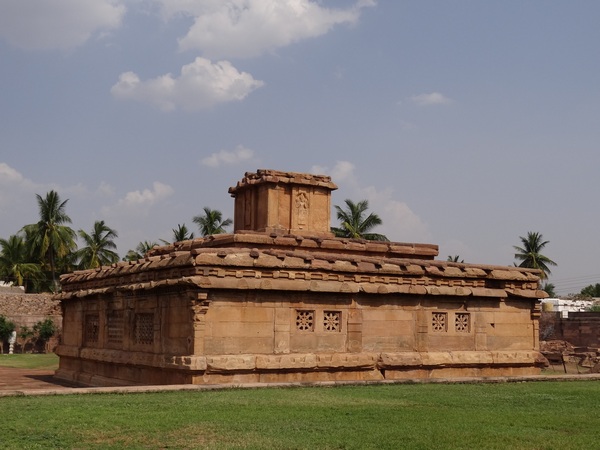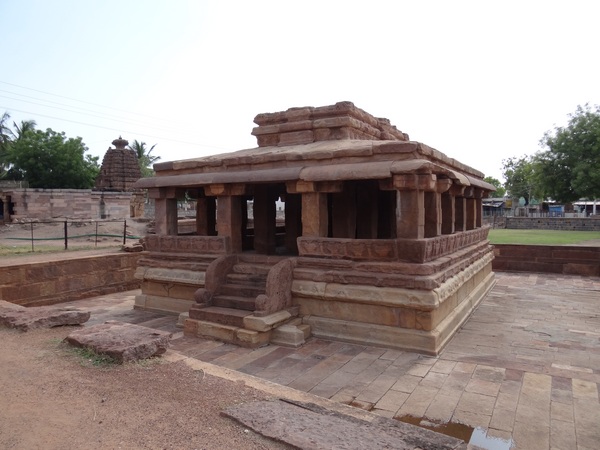 | « Back to article | Print this article |
IN PICS: The amazing Chalukyan temples
The temple complex at Aihole offers a fascinating insight into the history of Chalukyan temple architecture writes Nirdesh K Singh.
Karnataka is a veritable treasure chest of temples and monuments. Karnataka's monuments can be depicted stratigeographically from north to south. In the north, the group of neighbouring districts Bidar, Gulbarga and Bijapur perhaps has the largest cluster of tombs and monuments owing their lineage to the Bahmani Sultanate. Moving south 100 kms will bring you to the amazing temple sites of Badami, Pattadakal and Aihole showcasing the temple building skills of Early Chalukyas.
Moving further south by 150 kms will bring you to the glorious and lonely ruins of Hampi, capital of the once mighty Hindu empire of Vijayanagar. Continuing our journey southwards by 130 kms will bring us to the Stupendous Chitradurga Fort. Journeying down another 170 kms brings us to Belur with its beautiful temples belonging to the Hoysala Empire.
Continuing our voyage of discovery, Shravanabelagola with its Jain Temple Complex and Gommateshvara Bahubali statue lies about 90 kms south east of Belur. Srirangapatna lies about 70 kms south of Shravanabelagola. Srirangapatna has temples belonging to Ganga dynasty and forts and tombs associated with Tipu Sultan.
Another 20 kms is Mysore, the capital of Wodeyar dynasty. This roughly 1000 km journey provides a sumptuous treat of tombs, temples, palaces and ruins. No wonder Karnataka Tourism's tagline is 'Karnataka - One State. Many Worlds'.
Aihole on the banks of Malaprabha river was the first capital of the Early Chalukyas. The Chalukya Dynasty was founded by Pulakesi I in 543AD and ruled over Deccan India for over 600 years. To put history in perspective, this was the Vedic Renaissance period.
Elsewhere in India, Magadh dynasty had bit the dust and Gupta dynasty was on the verge of extinction; Ajanta Caves already had frescoes of Buddha, Aryabhat I had calculated the Pi value, and Balipal & Mahipal ruled Delhi.
According to legend, Parashuram vowed retribution when his father, the sage Jamadagani was killed by King Kartavirya. Jamadagani had refused to hand over his blessed Kamdhenu calf to the King. Parashuram vowed to kill all the Kshatriyas twenty one times after seeing his mother beat her chest twenty one times in grief. After killing all the Kshatriyas, he washed his axe in the Malaprabha.
The river turned red from all the blood. Women washing clothes downstream were alarmed and exclaimed "Ai Hole!" or "What a river!" And thus the place got the name Aihole. Some inscriptions in the temples also refer to Aihole as Aryapur.
IN PICS: The amazing Chalukyan temples
Pulakesi I was the son of a chief of Kadamba dynasty of Banavasi. As Kadamba's power waned, Pulakesi I saw his chance, wrested control, and set up the independent Chalukya dynasty. The dynasty was called Chalukyas of Badami or Early Chalukyas and it ruled between 6th and 8th century. During these 600 years, the Chalukyas ruled as three independent but related dynasties -- Chalukyas of Badami, Chalukyas of Kalyani or Western Chalukyas, and Chalukyas of Vengi or Eastern Chalukyas.
The Badami Chalukya era was a watershed time in the annals of Indian Temple Architecture. The construction style was called Chalukyan Architecture. Both rock cut or caves and structural temples were built. The Badamis went on wild spree of temple construction in the Malaprabha river basin. Locally found golden coloured sandstone provided the building material.
In a small concentrated area of about 40 kms more than a hundred temples and monuments were built. Aihole alone has 125 temples divided into 22 groups and therefore, Aihole is rightly regarded as the cradle of Hindu Temple Architecture.
Aihole is also regarded as the laboratory where the Chalukyan Architecture was perfected through fusion of northern Nagara style and southern Deccan style and which was then practised in Badami and Pattadakal. Aihole also served as the commerce centre of the Chalukyas with the trade guild headquartered here. It is believed that this guild sponsored the construction of several temples.
The temple construction stretched into three phases: In the first phase, in around 580AD, some rudimentary cave temples in Aihole and four developed cave temples in Badami were built. In the second phase, beginning from 600AD, majority of the 125 temples in Aihole were built. The temples built in Pattadakal in the 8th century represent the golden era of temple building of Badami Chalukyas.
If planning to visit Aihole, Pattadakal and Badami on the same day then it is recommended to visit the most popular temple complex in Aihole that houses the museum, Durga Temple and Lad Khan Temple in a small fenced area. This complex is ticketed by ASI and is neatly maintained with couple of temples undergoing renovation.
The pretty temples are surrounded by houses in all colour shades on all sides threatening to soon have their balconies hanging over the temple structures. With the sun burning down, only a few intrepid visitors are seen clutching water bottles. You don't want to be down with sunstroke before Hampi. You take it easy in the cool environs of mantapas.
IN PICS: The amazing Chalukyan temples
The Durga Temple is the most unique temple you have ever seen. It almost resembles a mini fort. And therefore probably it is named Durg or a fortress rather than dedicated to Goddess Durga. The sign says that it has apsidal plan but non-apsidal curvilinear shikhar. Can the ASI be more esoteric? But what you can understand is that the temple is a delight to look at and is emblematic of Aihole town.
A colonnaded corridor runs around the temple that allows parikrama or circumambulation. The pillars have some great carvings. The garbha griha or the sanctum sanctorum is topped with a broken shikhar. The temple was built in the 8th century during the times of the later king Vikramaditya II. The exquisite and detailed carving clearly shows that in 2 centuries since they started temple construction, the Chalukyan Architecture had reached its peak.
IN PICS: The amazing Chalukyan temples
Lad Khan Temple is one of the oldest temples in the complex probably built in 450 AD. It was initially used as a panchayat hall where Pulakesi I performed horse sacrifices. Later it was turned into a temple -- first Surya Temple and then Shivalay. Since it is early construction, the pillars are relatively carving free.
The most beautiful part of the temple is the lattice windows with intricate carvings taking inspiration from northern temples. The carving could have been a later addition to the temple once the appropriate skills had developed. The central square with flat roof houses the Nandi. The Nandi is surprisingly completely intact. Over the central square there is a broken shikhar which again could be a later addition. The temple got its name either from a general or a mendicant who lived here.
IN PICS: The amazing Chalukyan temples
Gaudura Temple appears to be the oldest of all Aihole temples. The temple has 16 pillars, a sanctum and parikrama path. This could be the Bhagwati Temple which was worshipped by the trading community of Aihole.
IN PICS: The amazing Chalukyan temples
There are few more temples in the complex: There is a 7th century Suryanarayan Temple with a Rekhanagar (curvilinear) shikhar; Badiger Gudi, a 9th century Surya Temple with a stepped well and 'Twin Temples' for lack of any identification sign.
Most of the photos carry rear views as all temples in the complex are east facing. With the low sun shining brightly in the late afternoon western sky it was practically impossible to photograph temples from the front.
Getting There:
Make Bagalkot district centre as your base. New Bagalkot is a clean and planned city about 550 kms north of Bangalore. You can visit all three sites Aihole, Pattadakal and Badami in a single day. But in case you want to visit all 22 or so groups of temples and the museum, then Aihole deservedly needs entire day.
Also, try to choose a cool day. The rocky terrain in May and June turns pretty hot with the temperature a nice scorching 42 degrees.
